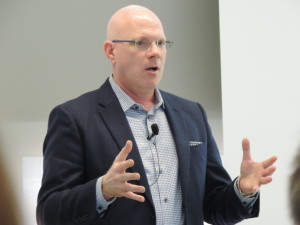In a six-day study in SyracuseCoE’s Total Indoor Environmental Quality Lab twenty-four professional employees – architects, designers, programmers, engineers, creative marketing professionals and managers – participated in a study examining the impact of green buildings on cognitive performance and decision-making performance. This week, researchers returned to SyracuseCoE to present the findings of this pioneering study to an audience of more than 140 total, including 70 via web and more than 70 in the room.
Study Info:
“The Impact of Green Buildings on Cognitive Function” study found that participants’ cognitive performance scores averaged 101 percent higher in green building environments with enhanced ventilation compared to a conventional building environment.
Researchers measured cognitive function for nine functional domains, including basic, applied and focused activity levels; task orientation; crisis response; information seeking; information usage; breadth of approach; and strategy. The largest improvements in cognitive function test scores was found in the areas of crisis response, information usage and strategy.
- Crisis response scores were 97 percent higher for the green environment and 131 percent higher for the green environment with enhanced ventilation and lower carbon dioxide levels compared to the conventional environment.
- Information usage scores for green and enhanced green environments were 172 and 299 percent higher than in the conventional environment, respectively.
- For strategy, green and enhanced green scores were 183 and 288 percent higher than the conventional environment.
Panelists and speakers:
Introduction by: John Mandyck, Chief Sustainability Officer, United Technologies Corporation.
- Joseph G. Allen, DSc, MPH, Principal Investigator, Assistant Professor of Exposure Assessment Science
- Piers MacNaughton, MS Project Manager, Doctoral Candidate
- Suresh Santanam, ScD, PE, Co-Investigator, Director, Industrial Assessment Center, Associate Professor, Biomedical and Chemical Engineering
- Usha Satish, PhD, Director, Strategic Management Simulations Institute for Human Performance
Because the study reflects conditions in indoor environments that many people encounter daily, these findings have far ranging implications for worker productivity, student learning, and safety.
Green building design that optimizes employee productivity and energy usage will require adopting energy efficient systems and informed operating practices to maximize the benefit to human health while minimizing energy consumption.
View the recorded webinar:
For more information about the Total Indoor Environmental Quality Lab, contact tlrosani@syr.edu.
See more at:
http://thecogfxstudy.naturalleader.com/
http://www.chgeharvard.org/resource/impact-green-buildings-cognitive-function



